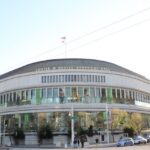The presence of illegal migrants in the Big Apple has significantly impacted the quality of life for residents and workers in areas overwhelmed with shelters, as reported by The Post. Concerns about safety and overpopulation have been raised by individuals like Maria Katirtzoglou, who works near a hotel-turned-migrant shelter in Long Island City. The 114th Precinct, which covers the shelter-saturated neighborhood, has seen a 12.3% increase in reported major crimes compared to the same period in 2022. Complaints to the city’s 311 hotline in the 11101 zip code have also surged since migrants were bussed to New York, with a 42% increase in reports.
Residents like Shawarn Shields and the Gleiber family have expressed frustrations with the behavior of migrants in their neighborhoods, citing concerns about safety, cleanliness, and disruptive activities. The Gleibers, who run a wooden box-making company, are considering relocating due to the disturbances caused by the migrant shelter across the street. In various neighborhoods like Jamaica and Midtown, residents have reported incidents of public disturbances, littering, and clashes with law enforcement involving migrants.
Overall, the influx of illegal migrants has sparked tensions and challenges for residents and businesses in affected areas of New York City.
The disparity in quality of life between the Upper West Side and Upper East Side has become apparent to long-time residents after data obtained by The Post revealed significant differences in the distribution of migrant shelters in the city.
While there are eight migrant shelters in zip codes on the Upper West Side, the Upper East Side only has one shelter located at the once-posh Bentley Hotel on E. 62nd Street.
UWS activist Maria Danzilo, 67, expressed frustration with the situation, stating, “It makes people who live on the Upper West Side frustrated that they can cross the block and go on a five-minute or 10-minute walk through [Central] Park, and it’s like being in a different city.”
Concerns among residents include migrants engaging in illegal activities such as racing mopeds, public intoxication, drug use, illegal street vending, and harassing outdoor diners for money.
Despite the complaints, Councilwoman Gale Brewer assured that the Upper West Side is handling the situation well, emphasizing the neighborhood’s liberal values.
Shawn Hill, co-founder of the Greater Harlem Coalition, expressed frustration over the lack of equitable distribution of shelters for housing migrants in Upper Manhattan.
Councilman Keith Powers and other officials echoed the sentiment that no single neighborhood should bear the burden of the migrant shelter crisis, emphasizing the need for fair distribution of civic infrastructure.
While some council members declined to comment on the issue out of concern for drawing attention to potential new shelter openings in their neighborhoods, a spokesperson for Mayor Eric Adams reassured the commitment to fair siting of shelters across the city.
“With more than 65,300 migrants currently in our care, and an average of over a thousand more continuing to arrive every week, we have used every possible corner of New York City to shelter asylum seekers in a compassionate and equitable way,” said mayoral spokesperson Liz Garcia.






